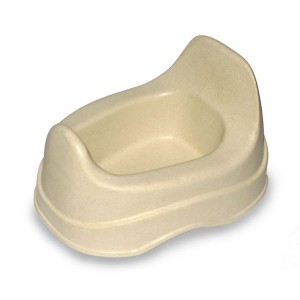My son has proudly reached the potty-training stage and I can’t tell you how much I am looking forward to never having to change nappies again.
So I’ve been thinking (and reading) a lot lately about ways to approach the whole process, and I started with a trip to a local baby supply store to see what was out there in terms of “potties”. All I can say is that this, like many experiences of buying products for my child, was overwhelming.
Is it better to get the seat that goes on top of your toilet? Or the separate potty that sits on the floor? What about the travel potty? And there are ones with Thomas the Tank or Dora the Explorer and every other kids brand you can think of. Should I let my son choose? Why are they all PLASTIC? Can they be recycled? What do you do with it when you’re done? Unlike toys or clothes, a potty is surely not something most people would hand down to someone else – so do all these potties become landfill?
 There has to be another option, I thought. And it turns out there is. I have found an eco-friendly version of a potty that’s new, and has some pretty nifty features. For one, it’s made from recycled plant materials that biodegrade naturally. Really?
There has to be another option, I thought. And it turns out there is. I have found an eco-friendly version of a potty that’s new, and has some pretty nifty features. For one, it’s made from recycled plant materials that biodegrade naturally. Really?
Yes. EcoLife International has created a potty made from bamboo and rice husks, that have been ground into a fine powder and then blended with biodegradable resin to form the potty seat, which looks exactly like most standard plastic potties in shape and size.
You can use it and clean it in exactly the same way as any plastic potty, and once your child is (finally!) done using it, then it’s time for a little lesson about recycling and gardening that is sure to be rewarding. You can plant the potty in your garden with some seeds and water, and soon it will biodegrade and turn into something beautiful! How’s that for incentive to use the potty?
The eco-potty also gets extra points for using minimal packaging – using only a small cardboard sleeve that is made from recycled paper and is also recyclable.
And for those worried that the eco potty won’t stand up to repeated washings or exposure to sunlight, there’s no need for concern – EcoLife tests these potties rigorously and they are said to have a life-span of at least a year. (It will only start to biodegrade after it’s been planted in your garden). With a price tag of $19.95 that’s pretty good value.
The EcoLife biodegradable potty is now available for the first time in Australia at Itty Bitty Greenie – click here for more details.

















